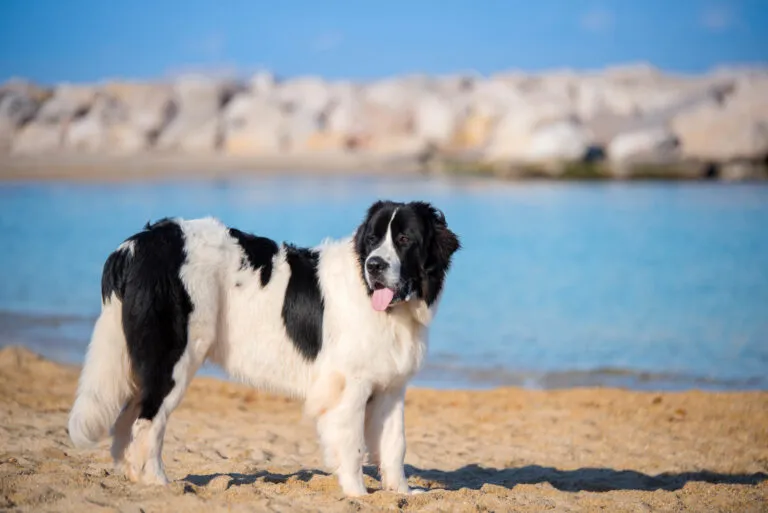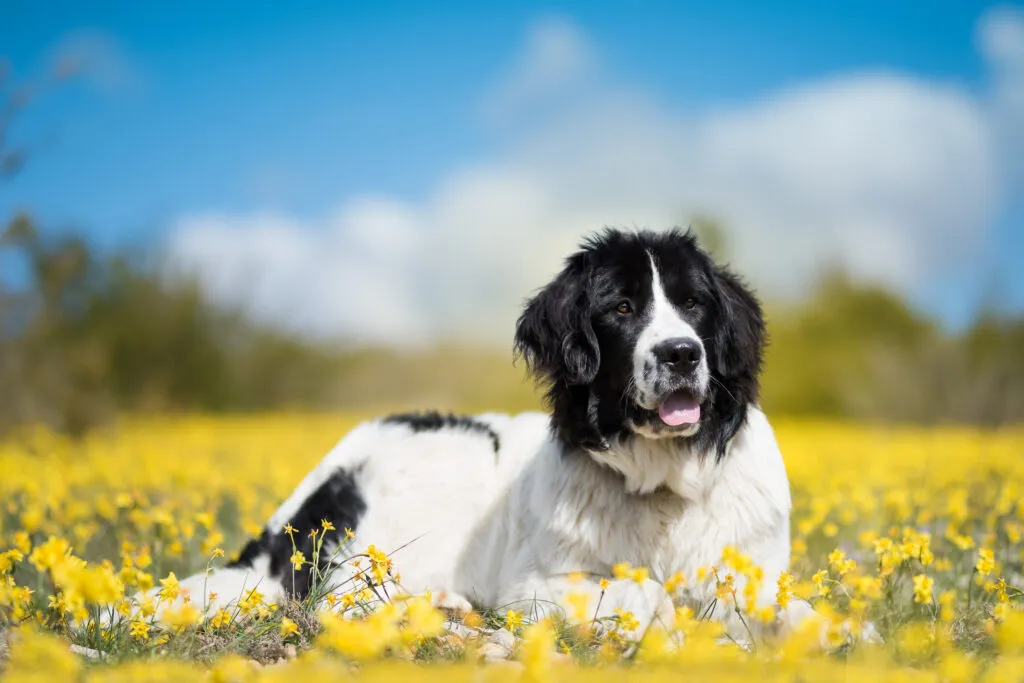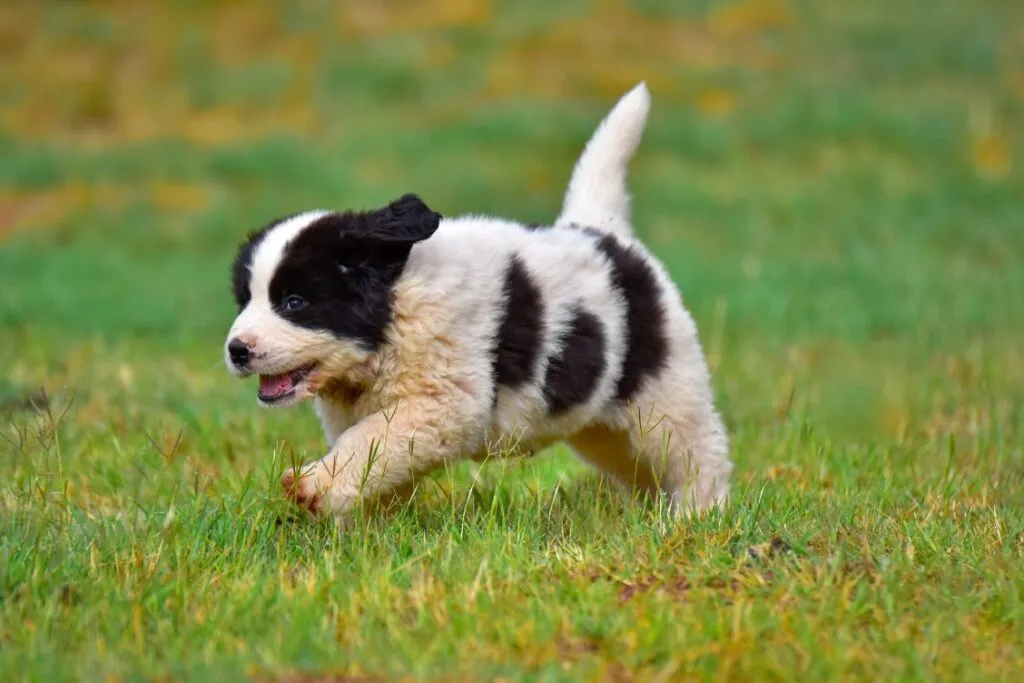Medium Size Poodle
The Landseer breed owes its name to the English painter Edwin Landseer, one of the most famous animal painters of the 19th century. His enthusiasm for the white-and-black giants with gentle temperaments is evident in many of his paintings.

© noemie / stock.adobe.com
The Landseer is easy to spot with its large size and black and white coat.
While the origin of this dog breed goes back a long way, the official recognition of the Landseer as an independent breed is relatively recent. In 1960, the FCI (Fédération Cynologique Internationale) recognised the Landseer as an independent breed.
Today, the breed is listed under number 226 and classified in Group 2 (Pinschers, Schnauzers, Molossoid breeds, Swiss Mountain and Cattledogs) and Section 2.2 (Mountain dogs).
Previously, Landseers were considered a type of Newfoundland dog, brought to England from the Canadian island of Newfoundland. The Newfoundland dog, valued for its love of water and exceptional work ethic by British fishermen, is likely a mix of dogs brought by the first European fishermen and the native dogs of Newfoundland.
As it was common to have dogs on ships, the large dogs of the Portuguese, Basques, and Spaniards (who visited Newfoundland’s rich fishing grounds before the British) mixed with the native dogs. Thus, Newfoundlands, today’s Landseers, and the Pyrenean Mountain Dogs probably share common ancestors.
When British seafarers brought these impressive water dogs to England, the “Newfoundland Dogs” quickly became popular. The aristocracy and upper middle class were particularly fond of these impressive giants.
In 1886, the “Newfoundland Club” was founded in England, breeding both the white-and-black, pure black, and red-brown types. Due to the dominant inheritance of the black fur colour, the white-and-black type was increasingly pushed back. By the end of the 19th century, the white-and-black type was almost forgotten in England.
The fact that the Landseer is recognised today as an independent breed is thanks to dog breeders from Germany and Switzerland. At the turn of the century, German and Swiss breeders brought the few remaining breeding dogs from England to Continental Europe and began the pure breeding of the white-and-black type.
Following the already widespread term for this colour variant of the Newfoundland, the new breed was named “Landseer.” The painter Edwin Landseer, who also preferred white-and-black dogs in his drawings, had made a name for himself with his animal paintings in the mid-19th century. In England, white-and-black Newfoundlands were referred to as “Landseer Dogs” at that time.
Besides the Landseer breed, recognised by the FCI in 1960, black-and-white Newfoundlands still exist today, but they are much less common than the black Newfoundlands.
The Landseer receives compliments not only for its “good manners” but also for its striking appearance. With a height at the withers between 72cm to 80cm for males and 67cm to 72cm for females, Landseers are undoubtedly among the large dog breeds. Males weigh between 60kg to 75kg, whereas females weigh around 50kg to 55kg.
Despite their huge size, long fur, and sometimes relaxed demeanour, Landseers are not clumsy. On the contrary, their bodies show muscle strength and energy, a trait that made them excellent working and water dogs for Canadian fishermen.
 © noemie / stock.adobe.com
© noemie / stock.adobe.com
The distinctive white-and-black coat colour is crucial to the Landseer breed’s development. Black patches are scattered over a clear white base on the body and rump. The neck, chest, belly, rod, and legs should be white. The white snout features a symmetrical white blaze on the black head. The black, triangular ears are medium-sized.
While the head is short-haired, the rest of the fur is long and dense. Despite its fullness, the coat feels fine to the touch. Slightly wavy top hair on the back and thighs is acceptable. The top coat is mixed with undercoat, but not as thick as its close relative, the black Newfoundland. Besides the differences in coat, the Landseer’s head is less massive with a slightly longer snout. Landseers also appear slightly larger and more agile than Newfoundlands.
The innate water passion of these dogs is showcased in Landseer’s 1856 painting “Saved,” featuring a black-and-white dog rescuing a child from water. This love for water and the ability to act independently in dangerous situations still makes the Landseer a popular water rescue dog today, used at lakes and coasts. However, as a family dog, the sociable canine friend is very popular.
With their calm, composed nature, loving gaze, and near-boundless good nature, Landseers charm every family member. They are particularly reliable and loyal to their people. Friendly and approachable, they adapt easily to various environments, making them ideal travel companions. They get along well with family friends and other pets like cats once accustomed to them.
To fully develop these traits, Landseers need close contact with their family. Kennel living is unsuitable for these affectionate dogs. They need to be with their people to feel happy and included. Despite their gentle nature, Landseers demand a firm place in the family, needing to be useful, whether helping with shopping bags or collecting toys in the house.
They enjoy tasks, not necessarily as challenging as training to be a rescue dog or avalanche dog, but even simple activities bring them delight. Only a firm yet loving hand is needed to satisfy and exercise a Landseer physically and mentally. They are content with daily walks that are not too demanding. A stroll through the forest or across fields suffices. A lake or stream for a quick swim induces sheer joy.
Though Landseers are lively and active, they are pleasant and quiet household dogs with little hunting instinct, and rarely use their barking. They are also more reserved than aggressive towards strangers. Their protective instinct makes them watchful but they quickly show their friendly and cheerful side when they know a guest is welcome.
Despite their ease of training and gentle temperament, Landseers need consistent training. These intelligent dogs can be quite independent, which might not always please their owners. However, with their quick learning ability and strong human orientation, even novices can train Landseers successfully, provided they follow basic rules.
Although Landseers are robust and mostly free of breed-specific diseases, they can still suffer from ailments common in large breeds. These include hip dysplasia (HD) and cartilage disorders. Heart diseases or gastric torsion are also occasionally diagnosed. Thankfully, the risk of such conditions can be minimized with proper care, ample exercise, regular vet check-ups, and suitable food. Better several smaller meals throughout the day than one large one.
Responsible breeding significantly contributes to the animals’ health. Only Landseers that meet strict criteria can be bred. With rigorous controls and exclusion procedures, the propensity for HD has been reduced.
The medical care of breeding animals, vaccinations, and tests, along with high-quality food for mother and puppies, are costly for the breeders. Prices around €1,000 per puppy often barely cover these expenses. Be cautious with significantly cheaper offers, as they usually ignore breeding guidelines, putting animals’ physical and mental health at risk.
 © noemie / stock.adobe.com
© noemie / stock.adobe.com
Landseers can live between 9 to 12 years with proper care and a healthy diet.
The perfect dog diet can’t be universally defined as each dog’s nutrient needs differ, depending on factors like activity level, health, and age. Generally, large dogs have higher energy needs than smaller ones. It’s crucial to monitor your pet’s weight as obesity can harm joints and organs. Always provide plenty of fresh water.
BARF (biologically appropriate raw feeding) offers an alternative to conventional dry and wet food, involving mostly raw meat, along with vegetables, fruits, offal, and supplementing minerals and vitamins. This feeding method requires expertise, so thorough research and consulting your vet is advisable to avoid malnutrition, which can severely harm your feline friend’s health.
If you decide to adopt a pedigree dog, don’t skimp on the purchase price. Seek a registered, reputable breeder more concerned with their dogs’ welfare than profit. A good breeder will thoroughly vet you for suitability and may advise you to reconsider if conditions aren’t ideal for a Landseer.
What are ideal conditions? Firstly, ample space is necessary. A large dog like a Landseer needs plenty of room at home and in the garden. City apartments are unsuitable for Landseers. A natural setting, a park, a forest, or fields for varied daily walks are essential, as is a garden for off-lead exercise. Daily walks needn’t be long. If there’s a stream or lake nearby, your Landseer will happily swim. To make your dog truly happy, ensure it can enjoy water regularly.
Equally important is proximity to its humans. Belonging to a family where the Landseer feels loved and needed is crucial for these gentle giants. With enough time and money (keeping such a large dog involves significant monthly costs), a long, happy relationship is likely. Rarely does any other being bring such a combination of affection, loyalty, good nature, and reliability as the Landseer.
Fans of the Bearded Collie agree that those who aren't familiar with this dog breed simply have to get acquainted with it. And those who have experienced how a Bearded Collie bolts across meadows with its flowing fur, how it rolls around full of energy and joy and how it attentively and observantly takes into account its owners wishes become simply addicted to this original dog breed and its unique charm.
The Goldendoodle isn't a breed, but a pairing between Golden Retrievers and Medium or Standard Poodles. Marketed as a low-maintenance dog for allergy sufferers, this hybrid is enjoying increasing popularity amongst dog lovers, similar to the Labradoodle.